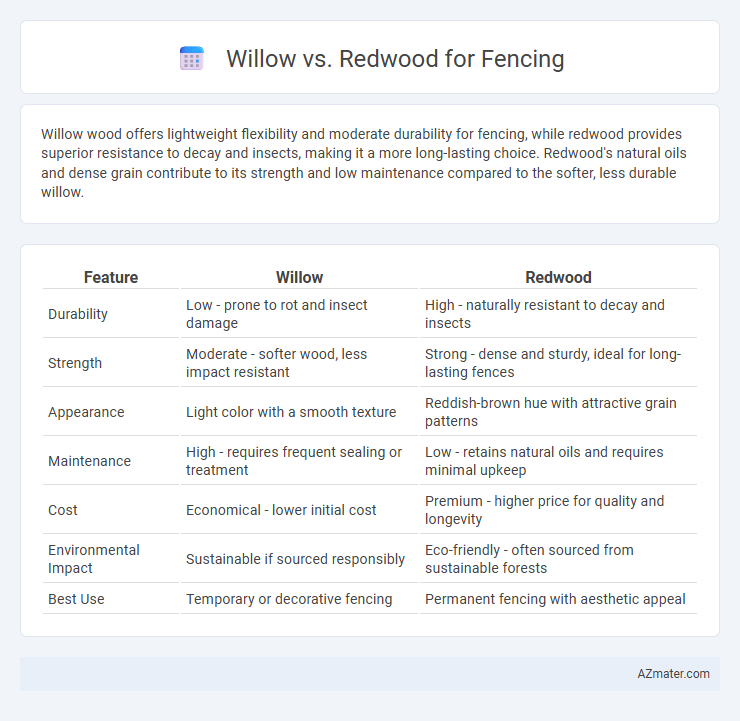Willow wood offers lightweight flexibility and moderate durability for fencing, while redwood provides superior resistance to decay and insects, making it a more long-lasting choice. Redwood's natural oils and dense grain contribute to its strength and low maintenance compared to the softer, less durable willow.
Table of Comparison
| Feature | Willow | Redwood |
|---|---|---|
| Durability | Low - prone to rot and insect damage | High - naturally resistant to decay and insects |
| Strength | Moderate - softer wood, less impact resistant | Strong - dense and sturdy, ideal for long-lasting fences |
| Appearance | Light color with a smooth texture | Reddish-brown hue with attractive grain patterns |
| Maintenance | High - requires frequent sealing or treatment | Low - retains natural oils and requires minimal upkeep |
| Cost | Economical - lower initial cost | Premium - higher price for quality and longevity |
| Environmental Impact | Sustainable if sourced responsibly | Eco-friendly - often sourced from sustainable forests |
| Best Use | Temporary or decorative fencing | Permanent fencing with aesthetic appeal |
Overview: Willow vs Redwood Fencing
Willow fencing offers lightweight flexibility and natural resistance to pests, making it ideal for temporary or decorative garden enclosures. Redwood fencing provides superior durability, weather resistance, and a rich reddish hue that enhances property aesthetics over time. Choosing between willow and redwood depends on the desired longevity, maintenance, and visual impact for outdoor boundary solutions.
Wood Grain and Aesthetic Differences
Willow fencing features a fine, smooth wood grain with a light, pale color that weathers to a soft gray, appealing for rustic, natural aesthetics. Redwood boasts a coarse, pronounced grain with rich reddish-brown hues that deepen over time, offering a warm and elegant appearance. The distinct grain patterns and color variations between willow and redwood create unique visual textures ideal for different landscaping styles.
Durability and Lifespan Comparison
Redwood fencing offers superior durability with natural resistance to decay, insects, and moisture, often lasting 20 to 30 years when properly maintained. Willow, while more affordable and lightweight, has a significantly shorter lifespan, typically enduring only 5 to 10 years due to its softer wood and susceptibility to rot. Investing in redwood fencing ensures a long-term barrier with minimal degradation, making it ideal for homeowners seeking longevity and low maintenance.
Resistance to Weather and Decay
Willow fencing offers moderate resistance to weather and decay but tends to absorb moisture, leading to faster deterioration in wet climates. Redwood is highly resistant to decay and weather, thanks to its natural oils and dense grain, making it a long-lasting choice for outdoor fencing. The superior durability of redwood significantly reduces maintenance needs compared to willow.
Maintenance Requirements
Willow fencing requires regular maintenance such as annual cleaning and occasional sealing to prevent rot and extend its lifespan. Redwood fencing is more durable and naturally resistant to insects and decay, demanding less frequent upkeep like occasional power washing and staining every few years. Choosing redwood significantly reduces maintenance efforts, making it ideal for long-term fencing solutions.
Cost and Availability
Willow fencing is generally more affordable due to the rapid growth and wide availability of willow trees, making it a cost-effective option for budget-conscious projects. Redwood fencing, while more expensive, offers greater durability and natural resistance to decay but is less abundant and typically sourced from limited regions in the western United States. Buyers seeking long-term investment often consider redwood despite higher initial costs, whereas willow suits short-term or decorative fencing needs with easy procurement.
Environmental Impact and Sustainability
Willow fences offer high sustainability due to their rapid growth rate and ability to regenerate after harvesting, making them an eco-friendly option with minimal environmental impact. Redwood, while durable and naturally resistant to decay, is slower-growing and often sourced from old-growth forests, raising concerns about deforestation and sustainability. Choosing willow supports renewable resource management and reduces carbon footprint compared to the more resource-intensive redwood fencing.
Installation: Ease and Considerations
Willow fencing is lightweight and flexible, making installation quick and manageable even for DIY projects, though it may require additional support due to lower durability. Redwood fencing offers a sturdier, more stable structure but demands professional installation because of its heavier weight and precise cutting needs. Both require proper treatment to prevent weather damage, with redwood typically needing less maintenance over time.
Suitability for Different Climates
Willow wood is best suited for temperate climates due to its moderate resistance to moisture and flexibility, making it ideal for fencing in regions with mild weather and occasional rainfall. Redwood offers superior durability and natural resistance to decay and insects, which enhances its performance in both humid, coastal environments and dry, hot climates. Choosing between willow and redwood for fencing depends heavily on local climate conditions, with redwood favored for long-lasting installations in harsh weather.
Final Verdict: Choosing the Right Wood for Your Fence
Willow wood offers lightweight and eco-friendly fencing options but lacks the durability and rot resistance found in redwood, which provides superior strength and longevity for outdoor use. Redwood's natural resistance to decay, insects, and moisture makes it a reliable choice for long-term fencing solutions, especially in diverse climates. Choosing redwood ensures a lasting, low-maintenance fence, while willow may suit budget-conscious projects with shorter lifespans or decorative purposes.

Infographic: Willow vs Redwood for Fencing
 azmater.com
azmater.com